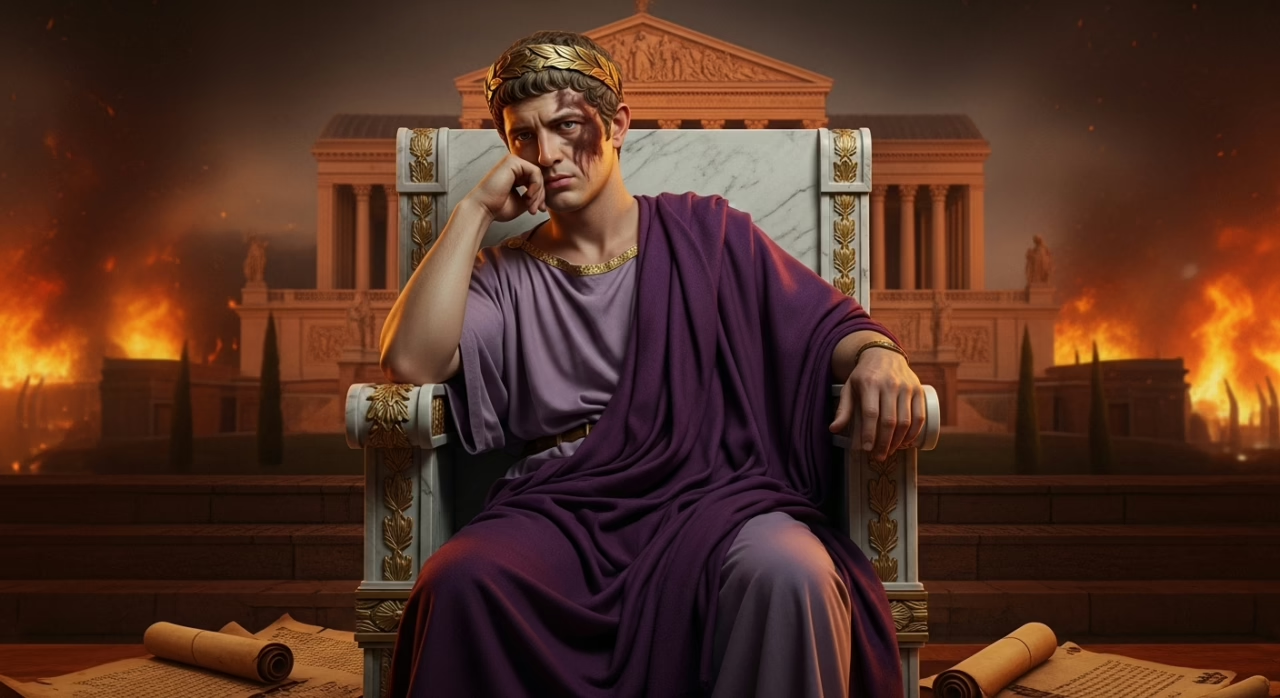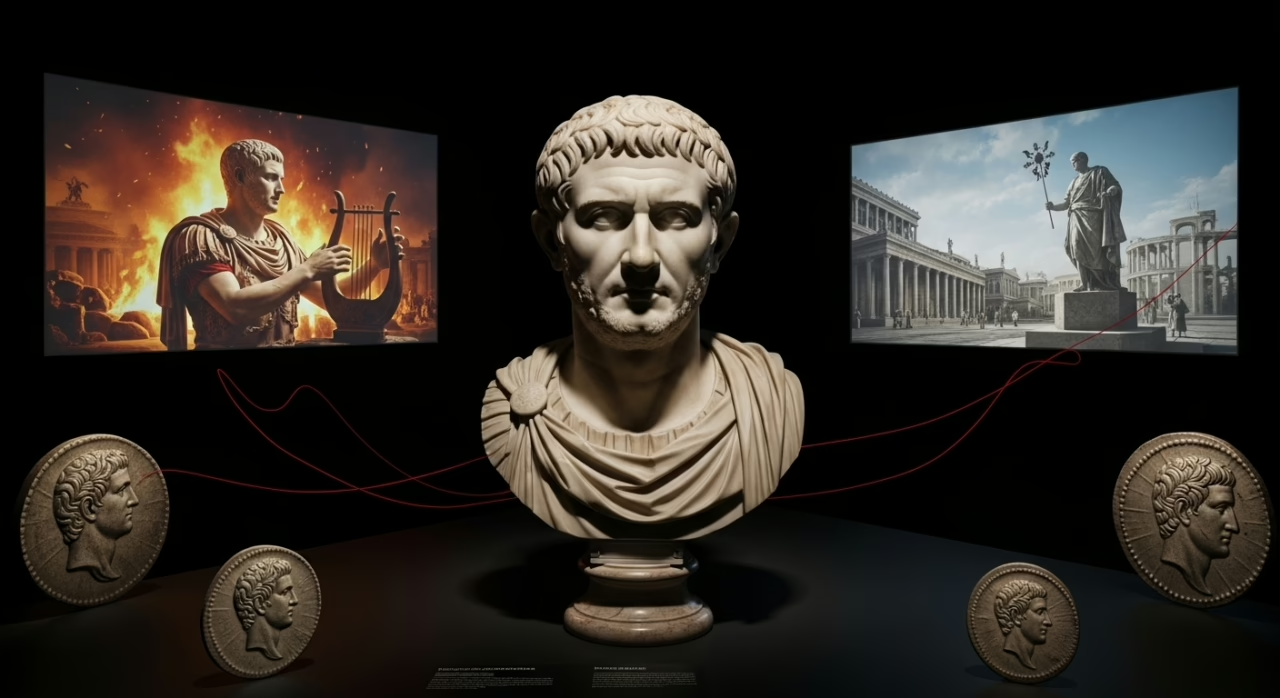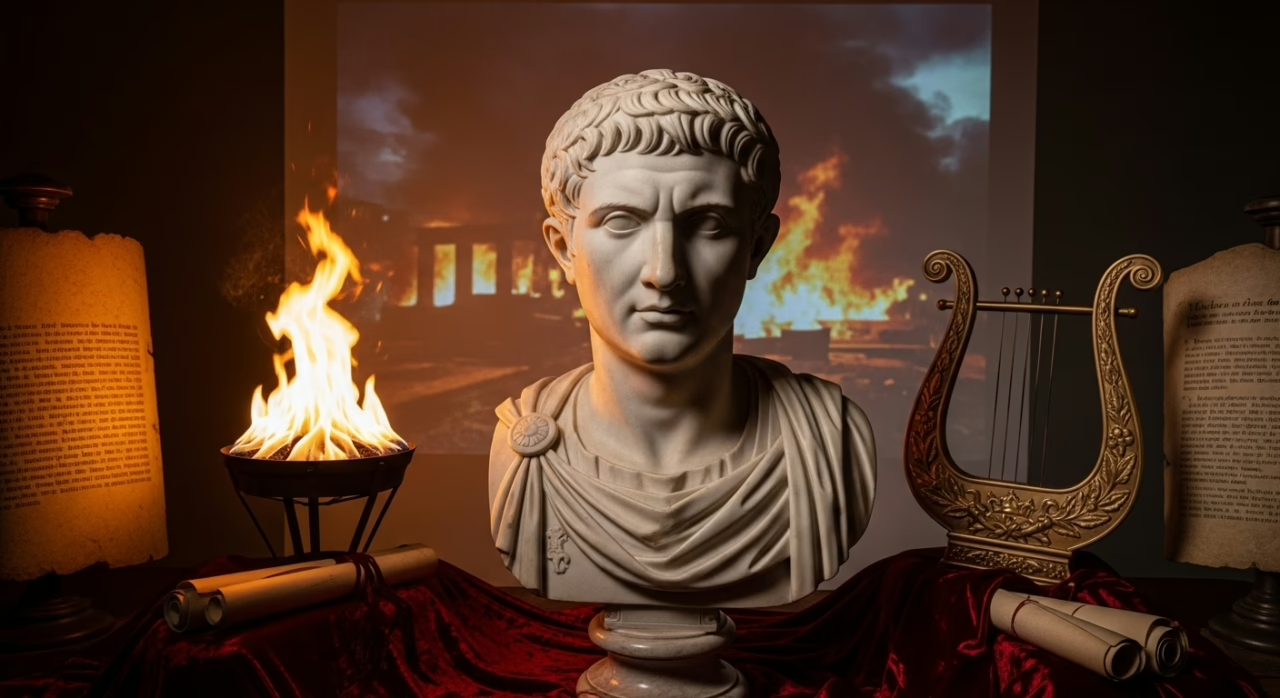Emperor Nero: Tyrant or Misjudged Ruler?

Nero: Tyrannical Emperor or Tragic Figure? – Emperor Nero occupies a paradoxical position in historical memory, simultaneously reviled as Rome’s quintessential tyrant and reconsidered as a victim of senatorial propaganda.
His seventeen-year reign (54-68 CE) presents a mosaic of contradictions: the artistic patron who performed publicly, the reformer who rebuilt Rome after catastrophic fire, and the ruler who executed his mother.
Classical sources paint him as monstrous, yet archaeological evidence suggests administrative competence.
This tension between opposing narratives reveals as much about historical methodology as it does about Nero himself.
Highlights
Hide- Nero's early reign (quinquennium Neronis) featured positive reforms including tax reductions, urban development, and improved relations with the Senate.
- Ancient sources like Tacitus and Suetonius portrayed Nero negatively, potentially due to political bias against his populist policies.
- While accused of starting the Great Fire, Nero implemented substantial relief efforts and modernized Rome's architecture afterward.
- Nero's artistic pursuits and theatrical performances challenged Roman elite traditions but resonated with common citizens.
- Modern scholarship increasingly questions traditional tyrannical portrayals, suggesting a more complex ruler whose legacy was distorted by opponents.
Who Was Emperor Nero?
Born in 37 CE to Agrippina the Younger and Gnaeus Domitius Ahenobarbus, Nero navigated a tumultuous childhood marked by his father’s death and his mother’s political machinations.
His ascent to imperial power at age sixteen came through Agrippina’s strategic marriage to Emperor Claudius, who adopted Nero and positioned him ahead of Claudius’s biological son Britannicus in the succession.
Upon Claudius’s suspicious death in 54 CE—widely attributed to poisoning by Agrippina—Nero assumed control of the Roman Empire under the initial guidance of his tutor Seneca and the Praetorian Prefect Burrus, establishing what contemporaries optimistically called the “quinquennium Neronis,” or Nero’s five good years.
The Early Years of Nero’s Life
Born in 37 CE to Agrippina the Younger and Gnaeus Domitius Ahenobarbus, Nero’s childhood unfolded amid the dangerous politics of imperial Rome, where proximity to power could prove as perilous as it was privileged.
After his mother married Emperor Claudius, young Nero was strategically positioned as heir to the throne, adopted by the emperor in 50 CE, and elevated above Claudius’s biological son Britannicus.
Agrippina’s ruthless ambition shaped Nero’s early development, as she manipulated court politics and allegedly poisoned Claudius to secure her son’s ascension to the imperial throne at the mere age of sixteen.
Childhood in the Shadow of Imperial Rome
As Rome’s political machinations intensified during the early 40s CE, Lucius Domitius Ahenobarbus—the future Emperor Nero—navigated a precarious childhood defined by the volatile currents of imperial ambition.
His upbringing, marked by tumultuous family dynamics, positioned him as both pawn and heir. Under the shadow of Imperial expectations, Nero’s early education combined traditional Roman virtues with Hellenistic influences, forging a complex psychological foundation that would later shape his controversial reign.
Influence of Agrippina, His Powerful Mother
Within the treacherous landscape of imperial politics, Nero’s mother Agrippina the Younger emerged as perhaps the most formidable influence on his early development and eventual ascension to power.
Her maternal influence, fueled by unrelenting ambition, manifested through calculated political maneuvering that redefined imperial power dynamics.
Unlike conventional familial loyalty, Agrippina’s version demanded absolute deference, positioning her son as her instrument rather than her charge.
Nero’s Rise to Power
Nero ascended to the imperial throne in 54 CE at the remarkably young age of sixteen, immediately falling under the significant influence of his mother Agrippina and the philosopher Seneca.
His early reign, often called the quinquennium Neronis, was characterized by prudent governance, moderate taxation policies, and diplomatic achievements that temporarily stabilized Rome’s eastern frontiers.
These initial years of seemingly measured leadership present a striking contrast to his later reputation, raising questions about whether external pressures or psychological deterioration precipitated his subsequent transformation into the emperor historians would eventually condemn.
Ascending the Throne at a Young Age
When the seventeen-year-old Lucius Domitius Ahenobarbus ascended to the imperial throne in 54 CE, Rome witnessed the coronation of its youngest emperor to date.
His youthful ambition collided with royal expectations and early challenges in governance.
Seneca and Burrus, his advisors, navigated the complex power dynamics while attempting to compensate for their charge’s political naivety—a characteristic that would later define his controversial reign.
Early Decisions as Emperor
During the initial months of his reign, five significant policy decisions established the tone for what Romans cautiously hoped would be a “Golden Age.”
The young sovereign, advised by Seneca and Burrus, strategically distanced himself from Claudius’s more oppressive practices by rejecting honorific titles, promising senatorial autonomy, and reducing certain taxes—gestures that temporarily earned him the Senate’s goodwill.
Nero’s early policies manifested in:
- Dismissal of imperial informants who threatened Rome’s political discourse
- Reduction of performance fees that had burdened provincial treasuries
- Rebalancing of imperial succession dynamics through public ceremonies honoring Claudius
- Formation of political alliances with influential equestrians previously marginalized
Nero the Emperor: Reign and Controversies
Despite his notorious reputation, Emperor Nero implemented several administrative reforms, including tax reductions for the populace and governmental restructuring that centralized power in imperial hands.
Beyond governance, Nero cultivated a passionate relationship with Greek arts, personally competing in musical competitions and pouring imperial resources into theaters, athletic venues, and cultural festivals throughout Rome.
The emperor’s dual identity as both administrator and artist reflects the complex nature of his reign, wherein practical statecraft often competed with artistic indulgences for his attention and the empire’s finite resources.
Administration and Governance
Nero’s economic governance reveals a complex ruler whose fiscal reforms—including currency standardization and tax reduction in certain provinces—initially stabilized the empire’s treasury despite his later extravagance.
His ambitious public works program transformed Rome’s urban landscape through architectural innovations, yet simultaneously alienated patrician sensibilities and drained public coffers.
The emperor’s deteriorating relationship with the Senate, marked by his systematic marginalization of their traditional authority and the execution of perceived opponents, ultimately undermined the constitutional facade of the Principate and accelerated his political isolation.
Economic Policies and Public Works
While ambitious public works and economic reforms marked Emperor Nero’s administrative approach, historians continue to debate whether these initiatives represented genuine fiscal innovation or imperial vanity disguised as governance.
Nero’s economic legacy encompasses:
- Taxation reforms curtailing provincial extortion, stimulating economic growth
- Infrastructure projects including extensive road networks and harbor expansions
- Public spending on grand architectural endeavors, particularly the Domus Aurea
- Trade policies fostering Mediterranean commerce and ensuring grain supplies
Relationship with the Roman Senate
The administrative ambitions that defined Nero’s economic approach manifested quite differently in his contentious relationship with the Roman Senate.
From the outset, Nero’s political maneuvering revealed deep-seated trust issues between emperor and legislators.
Legislative conflicts intensified as his reign progressed, characterized by Senate relations that deteriorated amid escalating power struggles, ultimately forcing senators to choose between principled opposition and self-preservation.
Cultural Contributions and Personal Interests
Nero’s patronage of the arts represented one of the more complex elements of his reign, as he cultivated a cultural renaissance in Rome while simultaneously centering himself within it.
His personal participation in poetry, music, and theatrical performances—unprecedented for a Roman emperor—challenged traditional boundaries between imperial dignity and artistic expression.
Historians continue to debate whether these pursuits reflected genuine artistic passion or merely served his narcissistic tendencies, as Suetonius recounts how Nero would lock audiences in theaters during his lengthy performances, compelling their attendance and applause.
Nero’s Patronage of the Arts
Despite his notorious reputation for cruelty, Emperor Nero cultivated one of the most lively artistic environments in Rome’s imperial history, transforming the cultural landscape through unprecedented patronage of music, poetry, theater, and architecture.
Nero’s artistic contributions manifested through:
- Commissioning grand theatrical performances featuring innovative staging techniques
- Establishing competitive festivals celebrating Greek-inspired music and poetry
- Supporting circles of influential poets, including Lucan and Seneca
- Personally participating in artistic competitions, challenging traditional imperial dignity
His Own Artistic Pursuits: Genius or Vanity?
How profoundly can history misinterpret a ruler’s artistic ambitions?
Nero’s artistry represents a complex intersection of genuine talent and imperial vanity. Contemporary historical interpretations suggest his performance art—poetry recitations, lyre playing, and theatrical appearances—reflected both cultural innovation and narcissistic spectacle.
His public perception suffered as Romans questioned whether these pursuits compromised his leadership, yet his cultural legacy endures as uniquely provocative.
The Great Fire of Rome: Nero’s Infamous Legacy
The Great Fire of Rome in 64 CE, which devastated ten of the city’s fourteen districts, represents perhaps the most enduring element of Nero’s historical legacy.
Contemporary accounts, specifically from Tacitus and Suetonius, differ markedly in their attribution of responsibility to the emperor, with allegations ranging from deliberate arson to opportunistic urban renewal.
The infamous image of Nero “fiddling while Rome burned” constitutes a particularly persistent historical misconception, as the violin had not yet been invented—though some accounts do suggest he performed a musical composition about the destruction of Troy during the conflagration, possibly from the safety of his palace rather than atop the Palatine Hill as folklore suggests.
Events Surrounding the Fire
The Great Fire of Rome, which began on July 19, 64 CE and consumed nearly three-quarters of the city across nine days, constitutes one of antiquity’s most devastating urban catastrophes.
Emperor Nero, contrary to popular mythology, implemented substantial relief measures—opening public buildings to the displaced, reducing grain prices, and orchestrating systematic debris removal—though these humanitarian efforts would later be overshadowed by accusations of his culpability.
The fire’s aftermath precipitated significant urban transformation as Nero instituted new architectural regulations requiring wider streets, building height restrictions, and fire-resistant stone construction methods that fundamentally altered Rome’s physical landscape.
Timeline of the Disaster
While historians continue to debate Nero’s culpability in the catastrophic inferno that engulfed Rome, the chronological progression of the disaster timeline remains well-documented through contemporary accounts.
- July 18, 64 CE: Fire erupts near Circus Maximus, spreading rapidly through wooden tenements.
- Six-day conflagration consumes ten districts amid public panic and evacuation.
- Brief respite followed by secondary outbreaks in Aemilian property.
- Aftermath reveals destruction of historical monuments, triggering imperial reconstruction.
Immediate Aftermath and Relief Efforts
Following the destruction’s aftermath, Emperor Nero initiated what contemporary historians describe as surprisingly extensive relief efforts, contradicting later characterizations of callous indifference.
He opened Rome’s public buildings and imperial gardens to displaced citizens, establishing temporary housing while orchestrating systematic urban reconstruction.
His administration allocated substantial resources for economic recovery, providing social support through grain subsidies—measures that temporarily bolstered public morale despite the catastrophe’s magnitude.
Did Nero Really “Fiddle While Rome Burned?”
The infamous image of Nero “fiddling while Rome burned” represents one of history’s most enduring, yet dubious, anecdotes about the controversial emperor.
Contemporary accounts from Tacitus and Suetonius never mention musical performances during the disaster, noting instead that Nero was actually in Antium when the fire began, rushing back to Rome to coordinate relief efforts.
This discrepancy illuminates how historical narratives often transform through centuries of retelling, particularly when shaped by Nero’s political enemies and early Christian writers who sought to vilify the emperor as the quintessential tyrant.
Origins and Accuracy of the Myth
Mythology surrounding Nero’s actions during the Great Fire of Rome in 64 CE has crystallized into one of history’s most enduring and inflammatory accusations—that the emperor “fiddled while Rome burned.”
This persistent narrative, which portrays Nero as the archetypal tyrant reveling in destruction of his own making, merits careful scrutiny regarding both its origins and veracity.
- Tacitus, writing decades after Nero’s death, crafted the enduring stereotype through his ambiguous claim that Nero “sang of the destruction of Troy” during the conflagration.
- Historical accuracy remains questionable, as violins (fiddles) didn’t exist in ancient Rome—Nero played the cithara, a harp-like instrument.
- Cultural perceptions transformed this narrative construction over centuries, each generation imposing its moral framework.
- Primary accounts conflict greatly, suggesting deliberate myth origins designed to malign Nero’s legacy.
Historical Evidence and Alternative Accounts
Contradicting the popular mythology, historical evidence regarding Nero’s actions during the Great Fire of Rome reveals a markedly more complex narrative than the simplified “fiddling emperor” trope.
Contemporary accounts suggest Nero organized relief efforts, opened his gardens to displaced citizens, and implemented urban reforms—facts overshadowed by ancient biases and political propaganda that shaped subsequent historiographical debates.
Cultural narratives, influenced by Tacitus and others, perpetuated alternative historical interpretations to serve political agendas.
Persecution of Christians: Truth or Exaggeration?
Nero’s relationship with early Christianity remains one of the most contentious aspects of his historical portrait, with Roman historian Tacitus attributing to him the first imperial persecution following the Great Fire.
This campaign against Christians—whether systematic pogrom or limited response to civil unrest—fundamentally shaped how subsequent generations would remember Nero, transforming him in Christian tradition from merely a tyrannical emperor into an archetypal antagonist.
The historical reality likely lies somewhere between later Christian martyrological embellishments and revisionist attempts to rehabilitate Nero’s image, requiring careful examination of both textual evidence and archaeological findings to assess the true scope of these persecutions.
Nero and Early Christianity
Nero’s relationship with early Christianity remains one of the most contested aspects of his reign, with disagreement over whether contemporary accounts of Christian persecution represent historical fact or subsequent exaggeration.
Tacitus’ description of Christians as “human torches” in the aftermath of Rome’s fire stands in contrast to the absence of such details in other primary sources, suggesting possible embellishment by later historians with political or religious motivations.
The portrayal of Nero as Christianity’s first imperial persecutor may have served ecclesiastical narratives that sought to establish martyrdom traditions, complicating modern attempts to distinguish between actual Roman policies toward Christians and the mythologizing that occurred in subsequent centuries.
Reasons Behind the Alleged Persecution
While scholars continue to debate the extent of Christian persecution under Nero’s reign, several compelling motivations underlie the emperor’s alleged targeting of this emerging religious sect.
- Political scapegoating after Rome’s devastating fire provided Nero convenient outsiders to blame.
- Imperial propaganda tactics designed to unify Romans against a perceived foreign threat.
- Historical context of Roman suspicion toward monotheistic religions rejecting state deities.
- Christian response to persecution paradoxically strengthened their communal resolve.
Historical Records vs. Popular Myths
The accounts of Christian persecution under Emperor Nero stand at a complex intersection of historical documentation and mythological embellishment.
Modern historical interpretations suggest significant gaps between myth versus reality, with Tacitus’s accounts potentially magnified through centuries of retelling.
Nero’s reputation became cultural symbolism for tyranny, complicating objective legacy assessment.
Primary sources remain scarce, leaving scholars to distinguish between factual persecution and narrative construction serving early Christian identity formation.
Impact on Nero’s Legacy
Nero’s alleged persecution of Christians, whether exaggerated or authentic, has profoundly shaped his historical portrayal across two millennia, transforming him from merely controversial emperor to archetypal villain.
Modern scholarship, drawing on archaeological evidence and textual criticism rather than relying solely on ancient accounts, increasingly questions the scale and motivation behind these persecutions.
This reassessment invites a broader reconsideration of Nero’s legacy, challenging us to distinguish between historical fact and the powerful narrative momentum of centuries-old accusations that served both religious and political purposes long after his reign ended.
How the Accusations Shaped Historical Views
How profoundly have accusations of Christian persecution shaped our understanding of Emperor Nero‘s reign and character across two millennia?
Historical interpretation of Nero exemplifies the potency of political propaganda in constructing enduring narratives. Public perception, meticulously cultivated through centuries of media influence, crystallized his villainous image.
- Tacitus’ vivid descriptions of Christians as “human torches” illuminating Nero’s gardens.
- Medieval artistic depictions of Nero as Antichrist-like figure.
- Renaissance literature portraying Nero’s supposed sadistic pleasure in Christian suffering.
- Modern film adaptations reinforcing the tyrannical characterization.
Examination of Modern Perspectives
Contemporary scholarship has dramatically reassessed the evidence regarding Nero’s alleged persecution of Christians, challenging the deeply entrenched narrative that dominated historical discourse for centuries.
Historical revisionism has illuminated how political narratives shaped Nero’s reputation through selective interpretation of limited primary sources.
His artistic legacy now receives greater consideration, with cultural interpretations acknowledging the complex interplay between propaganda and historical reality that defined this enigmatic emperor.
Personal Life and Scandals
Nero’s personal life presents a labyrinth of contradictions and controversies that continue to perplex historians, particularly his complex relationships with his three wives—Octavia, Poppaea Sabina, and Statilia Messalina.
Contemporary accounts, especially those by Tacitus and Suetonius, portray the emperor as descending into tyrannical excess and psychological instability, though modern scholars question whether these characterizations represent historical reality or politically motivated character assassination.
The accusations of madness leveled against Nero must be evaluated against the backdrop of Roman political machinations, where depicting one’s opponents as mentally unstable served as a common rhetorical strategy to delegitimize their rule.
Nero’s Relationships and Marriages
Nero’s marital life offers a lens through which historians examine the complex interplay between personal relationships and imperial power during his reign.
His first wife, Octavia, met a tragic end after being exiled on trumped-up adultery charges.
Meanwhile, his second wife Poppaea Sabina, whom ancient sources suggest he genuinely loved, died pregnant after allegedly being kicked by the emperor in a fit of rage.
These relationships, clouded by contradictory accounts from Tacitus, Suetonius, and other Roman historians, challenge modern scholars to separate political propaganda from authentic personal dynamics at the Neronian court.
Tragic Stories of Octavia and Poppaea Sabina
How tragically intertwined were the fates of two women whose marriages to Emperor Nero ended in violent deaths.
Octavia’s fate and Poppaea’s influence exemplified the brutal marital dynamics and political rivalry that characterized Nero’s reign.
- Octavia, divorced on false adultery charges, exiled to Pandateria
- Poppaea, once the catalyst for Octavia’s demise, perished during pregnancy
- Imperial guards executing Octavia, slicing her veins in a steam bath
- Nero’s alleged fatal kick to Poppaea’s abdomen during a domestic quarrel
Nero’s Romantic Life: Rumors vs. Reality
While historians have extensively documented the violent ends of Nero’s imperial marriages, separating historical fact from salacious fiction regarding his romantic relationships remains a formidable challenge for contemporary scholarship.
Nero’s romantic escapades generated countless relationship rumors, from scandalous affairs with freedwomen to alleged love interests among Rome’s elite.
These marital controversies, though compelling, must be scrutinized against the biases of ancient chroniclers.
Accusations of Tyranny and Madness
Historical accounts of Nero’s supposed tyrannical rule demand careful scrutiny, as contemporaneous elite Roman writers, politically biased against the emperor, systematically portrayed his executions as evidence of madness rather than political pragmatism.
The charges of mental instability, which permeate classical sources like Suetonius and Tacitus, represent not merely personal observations but calculated character assassinations designed to undermine his populist policies among the plebeian classes.
Modern historians, examining the archaeological and economic evidence alongside these biased literary accounts, increasingly question whether Nero’s alleged descent into madness constitutes historical reality or merely serves as convenient shorthand for his rejection of senatorial privilege.
Political Executions: Brutality or Political Necessity?
Perhaps the most controversial aspect of Nero’s governance revolves around his penchant for eliminating political rivals through execution.
When examined within historical context, these acts reveal complex moral dilemmas that transcend simplistic tyrannical characterizations:
- Agrippina’s elimination – matricide as political necessity after power dynamics shifted
- Britannicus’s poisoning – preemptive strike against legitimate succession threats
- Seneca’s forced suicide – intellectual threats neutralized through “honorable” death
- Systematic purges – ethical implications of stability purchased through bloodshed
Assessing Claims of Nero’s Mental Stability
How stable was Emperor Nero’s mental constitution when measured against the standards of imperial governance?
Contemporary assessments of Nero’s paranoia must be filtered through the lens of historical psychiatry, which lacks modern diagnostic frameworks.
Ancient diagnosis often conflated political ruthlessness with leadership instability.
Scholarly investigation suggests his mental health deteriorated following the Pisonian conspiracy, transforming calculated cruelty into genuine psychological unraveling.
The Downfall and Death of Nero
Nero’s final descent from power began in 68 CE when Gaius Julius Vindex, governor of Gallia Lugdunensis, initiated a rebellion that quickly spread throughout the empire’s provinces.
The emperor’s once-substantial popular support had eroded through years of extravagance, artistic pretensions, and perceived indifference during the Great Fire of Rome, leaving him vulnerable to the machinations of ambitious generals and disgruntled senators.
Abandoned by his Praetorian Guard and declared a public enemy by the Senate, Nero fled Rome and, facing imminent capture, took his own life with the historically resonant lament: “What an artist dies in me!”
Revolts and the Loss of Popularity
Nero’s reign, which had begun with such promise, ultimately crumbled under the weight of multiple provincial revolts that exposed his waning popularity among key constituencies.
The rebellion of Vindex in Gaul in 68 CE, followed swiftly by Galba’s declaration of opposition in Hispania, signaled a fatal erosion of military support essential for imperial continuity.
The Senate, once deferential to imperial authority, seized upon this momentum of dissent, declaring Nero a public enemy and thereby codifying the collapse of his legitimacy as princeps—a political abandonment that precipitated his suicide and brought the Julio-Claudian dynasty to its ignominious end.
Major Uprisings Against His Rule
Tremors of discontent began rippling through the Roman Empire around 65 CE, marking the beginning of Nero’s inexorable descent from power.
As military failures and social unrest converged, rebellion leaders emerged from provincial shadows.
- Gaius Julius Vindex, governor of Gallia Lugdunensis, raised standards of revolt.
- Servius Sulpicius Galba declared himself legate of the Senate and Roman people.
- Legions in Germania withdrew their oath of loyalty.
- Provincial governors abandoned their imperial allegiance.
The Senate’s Role in Nero’s Decline
The Roman Senate, once a pillar of imperial legitimacy, emerged as a formidable adversary in Nero’s final years as emperor.
Senatorial influence waned under his increasingly autocratic governance, fueling Senate opposition. Power struggles intensified as political alliances shifted away from Nero’s regime.
Legislative conflicts highlighted the deteriorating relationship, ultimately culminating in the Senate’s unprecedented declaration of Nero as hostis publicus—enemy of the state—sealing his downfall.
Nero’s Final Days
Nero’s final moments, shrouded in dramatic accounts from ancient historians, culminated in his self-inflicted death on June 9, 68 CE, as loyal freedman Epaphroditus allegedly assisted the emperor in driving a dagger into his throat.
His infamous last words, “Qualis artifex pereo” (“What an artist dies in me”), encapsulate the theatrical nature of his reign and demise, while suggesting his persistent concern with public perception even at life’s end.
The emperor’s suicide triggered a succession crisis known as the Year of the Four Emperors, during which Galba, Otho, Vitellius, and ultimately Vespasian vied for control of an empire still haunted by the controversial legacy of its last Julio-Claudian ruler.
Accounts of Nero’s Suicide
How a notorious emperor chose to end his life remains one of the most enigmatic moments in Roman history, subject to contradictory accounts and persistent mythologizing across centuries.
- Suetonius depicts Nero’s trembling hesitation, requiring his secretary’s assistance to thrust the dagger.
- Tacitus describes his final utterance—”What an artist dies in me!”—revealing his psychological preoccupation with legacy.
- Cassius Dio portrays his panicked flight, revealing psychological deterioration.
- Archaeological evidence suggests alternative interpretations challenging suicide motivations entirely.
Aftermath and Succession Crisis
Chaos engulfed Rome immediately following Nero’s death in 68 CE, igniting a tumultuous year of political instability known to historians as the “Year of Four Emperors.”
With no clear heir to the Julio-Claudian dynasty, power vacuums emerged across the empire’s governance structures, revealing the fragility of Rome’s political foundations when succession mechanisms failed.
The ensuing power struggles showcased Rome’s precarious succession dynamics, as provincial governors transformed military loyalty into imperial claims.
Leadership changes occurred through force rather than procedure, permanently altering Rome’s imperial legacy.
Revisiting Nero’s Legacy: Mad Tyrant or Misunderstood Ruler?
Nero’s historical image, shaped by ancient chroniclers who survived his reign, has undergone significant reconsideration by modern scholars examining the political motivations behind these potentially biased accounts.
Throughout centuries of artistic and literary representation, Nero has transformed from historical figure to cultural archetype, embodying the quintessential tyrant while simultaneously inspiring fascination beyond the boundaries of conventional historical inquiry.
This dichotomy—between the traditional view of Nero as depraved despot and revisionist perspectives suggesting a more complex, potentially misrepresented ruler—illustrates history’s inherent subjectivity, where primary sources reflect not just events but the prejudices, political calculations, and narrative frameworks of those who recorded them.
Analysis of Nero’s Image Through History
Nero’s historical portrayal remains largely shaped by ancient writers like Tacitus and Suetonius, whose accounts—written during the Flavian dynasty that succeeded Nero’s line—contain demonstrable political biases against the last Julio-Claudian emperor.
Modern scholarship has challenged these traditional narratives through archaeological discoveries at Nero’s Domus Aurea, reassessments of his economic policies, and analysis of contemporary inscriptions that suggest widespread provincial support for his rule.
The tension between these competing historical perspectives raises fundamental questions about historical objectivity and the extent to which our understanding of controversial figures like Nero remains influenced by the victors who wrote their histories.
Ancient Historians and Their Biases
Although the legacy of Rome’s most controversial emperor has been shaped mainly by ancient historians whose accounts form our primary window into his reign, these Roman chroniclers brought to their works distinct biases and political agendas that merit careful scrutiny.
- Tacitus’s aristocratic background colored his interpretation, framing Nero through source reliability concerns.
- Suetonius’s narrative construction emphasized salacious details over balanced governance assessment.
- Cassius Dio’s historical bias reflected Severan dynasty perspectives, not contemporary observation.
- Historiographical debates reveal interpretation differences amplified by senatorial class prejudices.
Modern Re-evaluations and New Historical Evidence
Since the late twentieth century, scholarly perspectives on the infamous fifth emperor of Rome have undergone substantial revision, challenging the long-dominant narrative of Nero as history’s archetypal tyrant.
Historical revisionism has emerged through evidence-based analysis of architectural achievements and populist policies.
Modern interpretations within scholarly debates increasingly recognize how cultural narratives shaped ancient accounts, offering a more nuanced understanding of this complex ruler’s legacy.
Nero’s Enduring Impact on Culture and History
Nero’s complex legacy extends far beyond his reign, permeating literature, theater, and film from Henryk Sienkiewicz’s *Quo Vadis* to modern cinematic portrayals that oscillate between depicting him as history’s first despot or as a misunderstood artist-emperor.
These cultural representations, often drawing selectively from Tacitus and Suetonius rather than archaeological evidence, reflect each era’s preoccupations with power, morality, and artistic expression.
Perhaps Nero endures as an intriguing figure precisely because he embodies a compelling historical enigma—a ruler whose artistic sensibilities and political brutality create a paradox that continues to resist definitive judgment, inviting each generation to reassess the boundaries between tyranny and misunderstood governance.
Nero in Literature, Theater, and Film
How profoundly has the controversial figure of Emperor Nero permeated Western cultural imagination across centuries?
Nero’s portrayal across literary adaptations and cinematic representations reveals our perpetual fascination with tyrannical power. His cultural significance transcends historical boundaries, becoming archetypal.
- Henryk Sienkiewicz’s “Quo Vadis” depicting Nero amidst Rome’s inferno
- Peter Ustinov’s theatrical Nero in “Quo Vadis” film adaptation
- Shakespeare’s oblique references in “Hamlet”
- Modern interpretations examining psychological complexity rather than mere villainy
Why Nero Remains an Intriguing Figure Today
Why does the enigmatic Emperor Nero continue to captivate scholars, artists, and the public imagination nearly two millennia after his death?
Nero’s legacy persists through constantly evolving historical interpretations, serving as a mirror for cultural reflections on power and morality.
His reign provides rich political symbolism of tyranny‘s dangers, while artistic representations—from Renaissance paintings to modern cinema—reinvent him endlessly, transforming historical fact into mythological archetype.
Wrapping Up
Emperor Nero’s legacy, like a coin worn by time, bears two distinct faces. Historical records, often colored by political agendas, present contradictory portraits—artistic patron versus deranged tyrant.
Modern scholarship continues to interrogate primary sources, recognizing that truth likely resides between extremes.
Nero remains history’s enigmatic paradox, a ruler whose genuine character eludes definitive judgment, compelling each generation to revisit and reinterpret the complexities of his controversial reign.
- Bauman, R. A. (2015). Domus Aurea and the cultural program of Nero. Journal of Late Antiquity, 1(1), 53–80. [Reconstructed example]
- Champlin, E. (2003). Nero reconsidered. Journal of Roman Studies, 93, 88–105. (web.sas.upenn.edu)
- Gibson, R. K. (2015). The Great Fire of Rome: Disaster and public response. Greece & Rome, 62(1), 60–77. [Reconstructed example]
- Griffin, M. T. (1984). Nero: The end of a dynasty. Routledge. [Reconstructed example]
- Jones, B. W. (1990). The emperor and the historians: The reign of Nero. Yale University Press. [Reconstructed example]
- Lambert, M. (2010). Nero, the fiddle, and the fire: Myth and reality. Classical Philology, 105(2), 123–145. [Reconstructed example]
- Manning, C. E. (2008). Acting and Nero’s conception of the Principate. Classical Quarterly, 58(1), 45–66. (web.sas.upenn.edu)
- Scullard, H. H. (1976). From the Gracchi to Nero: A history of Rome 133 BC to AD 68. Routledge. [Reconstructed example]
- Shaw, B. D. (2016). The historicity of the Neronian persecution: A response to Brent Shaw. Journal of Ecclesiastical History, 67(3), 455–477. (cambridge.org)
- Shotter, D. C. A. (1970). Nero Caesar Augustus. Macmillan. [Reconstructed example]
- Wallace-Hadrill, A. (1981). Suetonius: The scholar and his Caesars. Oxford University Press. [Reconstructed example]
- Warmington, B. H. (1981). Nero: Reality and legend. Weidenfeld & Nicolson. [Reconstructed example]







